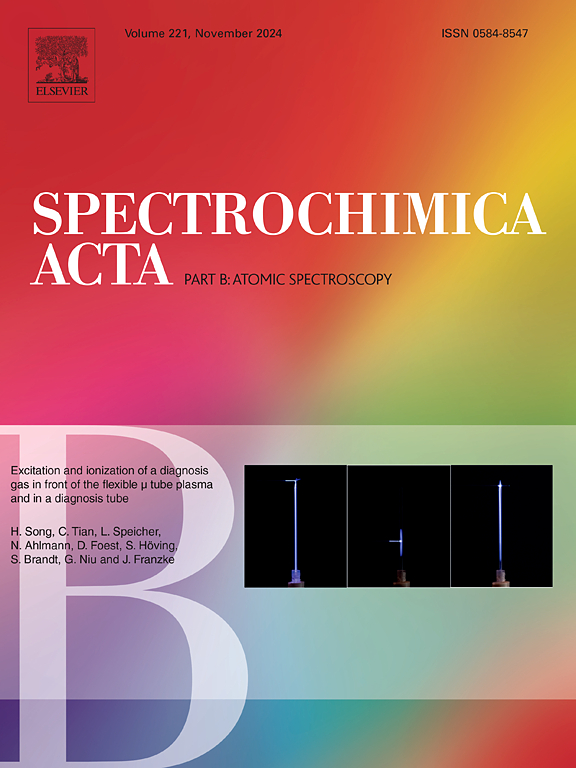应用TXRF测定糖尿病人血液中多种微量元素的浓度水平:与化学计量学方法的比较分析
IF 3.8
2区 化学
Q1 SPECTROSCOPY
引用次数: 0
摘要
微量元素在糖尿病的发生和发展中的作用一直是广泛研究的主题。血液等生物流体的多元素谱分析可以提供有关疾病机制、代谢过程和潜在诊断生物标志物的重要信息。全反射x射线荧光(TXRF)作为一种强大的多痕量元素分析工具,特别是在生物科学中得到了广泛的关注。由于糖尿病患病率的增加,本研究采用S2-PICOFOX TXRF样品稀释法研究了糖尿病患者(n = 100)和健康人(n = 150)全血样本中多种微量元素的浓度水平。微量元素包括P、S、Ca、Cr、Fe、Ni、Cu、Zn、Se、Br、Rb、Bi和微量元素Cl、k,结果显示差异有统计学意义(P <;0.05)血液样本之间K、Ca、Cr、Ni、Br和Rb水平的差异。通过主成分分析和Spearman等级相关分析等化学计量学方法进行对比分析,了解两组元素的分布规律和元素浓度之间的相关性。本研究强调了TXRF结合化学计量学方法作为一种快速有效的微量元素分析方法在临床诊断中的应用,为糖尿病管理和监测提供了有价值的元素相关生物标志物。本文章由计算机程序翻译,如有差异,请以英文原文为准。

Application of TXRF for exploring the concentration levels of multi-trace elements in human diabetes blood: A comparative analysis with a chemometric approach
The role of trace elements in the onset and progression of diabetes mellitus has been the subject of extensive research. Multi-elemental profiling of biological fluids like blood can provide vital information regarding disease mechanisms, metabolic processes, and potential biomarkers for diagnosis. Total reflection X-ray fluorescence (TXRF) has gained significant attention as a powerful analytical tool for multi-trace elemental analysis, particularly in the biological sciences. Due to the increasing prevalence of diabetes, this study investigates the concentration levels of multi-trace elements in whole blood samples from diabetic (n = 100) and healthy persons (n = 150) using S2-PICOFOX TXRF with a sample dilution method. Trace elements were quantified, including P, S, Ca, Cr, Fe, Ni, Cu, Zn, Se, Br, Rb, Bi, and microelements Cl and K. The results revealed statistically significant differences (p < 0.05) in the K, Ca, Cr, Ni, Br, and Rb levels between the blood samples. A comparative analysis with a chemometric approach, such as principal component analysis and Spearman's rank correlation analysis, was conducted to understand the distribution patterns of elements and correlations between elemental concentrations in both groups. This study highlights the application of TXRF combined with chemometric methods as a rapid and effective approach for trace element analysis in clinical diagnostics, providing valuable insights into element-related biomarkers for diabetes management and monitoring.
求助全文
通过发布文献求助,成功后即可免费获取论文全文。
去求助
来源期刊
CiteScore
6.10
自引率
12.10%
发文量
173
审稿时长
81 days
期刊介绍:
Spectrochimica Acta Part B: Atomic Spectroscopy, is intended for the rapid publication of both original work and reviews in the following fields:
Atomic Emission (AES), Atomic Absorption (AAS) and Atomic Fluorescence (AFS) spectroscopy;
Mass Spectrometry (MS) for inorganic analysis covering Spark Source (SS-MS), Inductively Coupled Plasma (ICP-MS), Glow Discharge (GD-MS), and Secondary Ion Mass Spectrometry (SIMS).
Laser induced atomic spectroscopy for inorganic analysis, including non-linear optical laser spectroscopy, covering Laser Enhanced Ionization (LEI), Laser Induced Fluorescence (LIF), Resonance Ionization Spectroscopy (RIS) and Resonance Ionization Mass Spectrometry (RIMS); Laser Induced Breakdown Spectroscopy (LIBS); Cavity Ringdown Spectroscopy (CRDS), Laser Ablation Inductively Coupled Plasma Atomic Emission Spectroscopy (LA-ICP-AES) and Laser Ablation Inductively Coupled Plasma Mass Spectrometry (LA-ICP-MS).
X-ray spectrometry, X-ray Optics and Microanalysis, including X-ray fluorescence spectrometry (XRF) and related techniques, in particular Total-reflection X-ray Fluorescence Spectrometry (TXRF), and Synchrotron Radiation-excited Total reflection XRF (SR-TXRF).
Manuscripts dealing with (i) fundamentals, (ii) methodology development, (iii)instrumentation, and (iv) applications, can be submitted for publication.

 求助内容:
求助内容: 应助结果提醒方式:
应助结果提醒方式:


